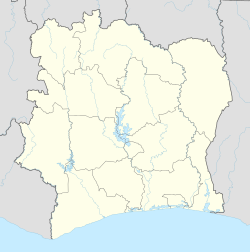Comoé National Park
|
Comoé National Park Ivory Coast , West Africa |
||
|---|---|---|
| SURFACE | 11,671,665 km² | |
| IUCN category | II; National Park (since 1988) | |
| Coordinates: Lat Long WGS 84 | ||
| NW corner coordinates | 9 ° 36 ′ 27 ″ N , 4 ° 16 ′ 16 ″ W. | |
| SE corner coordinates | 8 ° 35 ′ 39 ″ N , 3 ° 13 ′ 22 ″ W. | |
|
Ivory Coast |
||
The Comoé National Park (French: Parc national de la Comoé ), named after the river that flows through the park, is located in the northeast of the Ivory Coast at an altitude of 120 to 660 m and is the largest national park in West Africa with 11,500 km². With a north-south extension of about 120 km, it encompasses a broad spectrum of vegetation types from the Sudanese vegetation zone in the north to the Guinea zone in the southwest. It was added to the UNESCO Natural Heritage List in 1983 .
flora
The vegetation is strongly influenced by anthropogenic fires at the end of the dry season. This prevents the development of semi-evergreen forests and promotes savannas, which cover around 85% of the area of the park. In this area a double peaked rainy season can be observed with a maximum in April / May and another in August / September. The total amount of precipitation is around 1000 to 1200 mm per year. During the dry season from October to March, precipitation is very rare and unpredictable. In the south the park is bordered by gallery forests .
fauna
In the Comoé National Park there are many horned animals such as cob antelopes , West African hartebeest , bongos , waterbuck , roan antelopes and especially many oribis , as well as some species of monkeys . In addition to a good population of leopards , there are also said to be individual lions .
threat
The civil war in Ivory Coast has increased poaching and the unique wildlife of Comoé National Park has been acutely threatened. In 2003 it was therefore included in the Red List of World Heritage in Danger by the World Heritage Committee . In 2017 the committee decided to remove the national park from the red list.
Research station
One of the most modern research stations in West Africa is also located in the park. Research areas are animal and plant ecology, behavior, evolution, biodiversity and nature conservation.
literature
- Wally and Horst Hagen: The African national parks as habitats for elephants . In: Vitus B. Dröscher : Save the elephants of Africa . 1990, p. 210.
Web links
- Homepage of the research station
- Entry on the UNESCO World Heritage Center website ( English and French ).
- WCMC (PDF; 111 kB)
- World database on protected areas
- Comoé observatory of the BIOTA project
- Fritz Habekuss: The Patron and His Paradise , Zeit article from March 28, 2015
- Camera trap video on the animals of the Comoé National Park
Individual evidence
- ↑ UNESCO World Heritage Center: Comoé National Park. Retrieved August 20, 2017 .
- ↑ Communication from the World Heritage Committee of July 4, 2017
Coordinates: 9 ° 7 ′ 48.3 " N , 3 ° 45 ′ 24.3" W.





